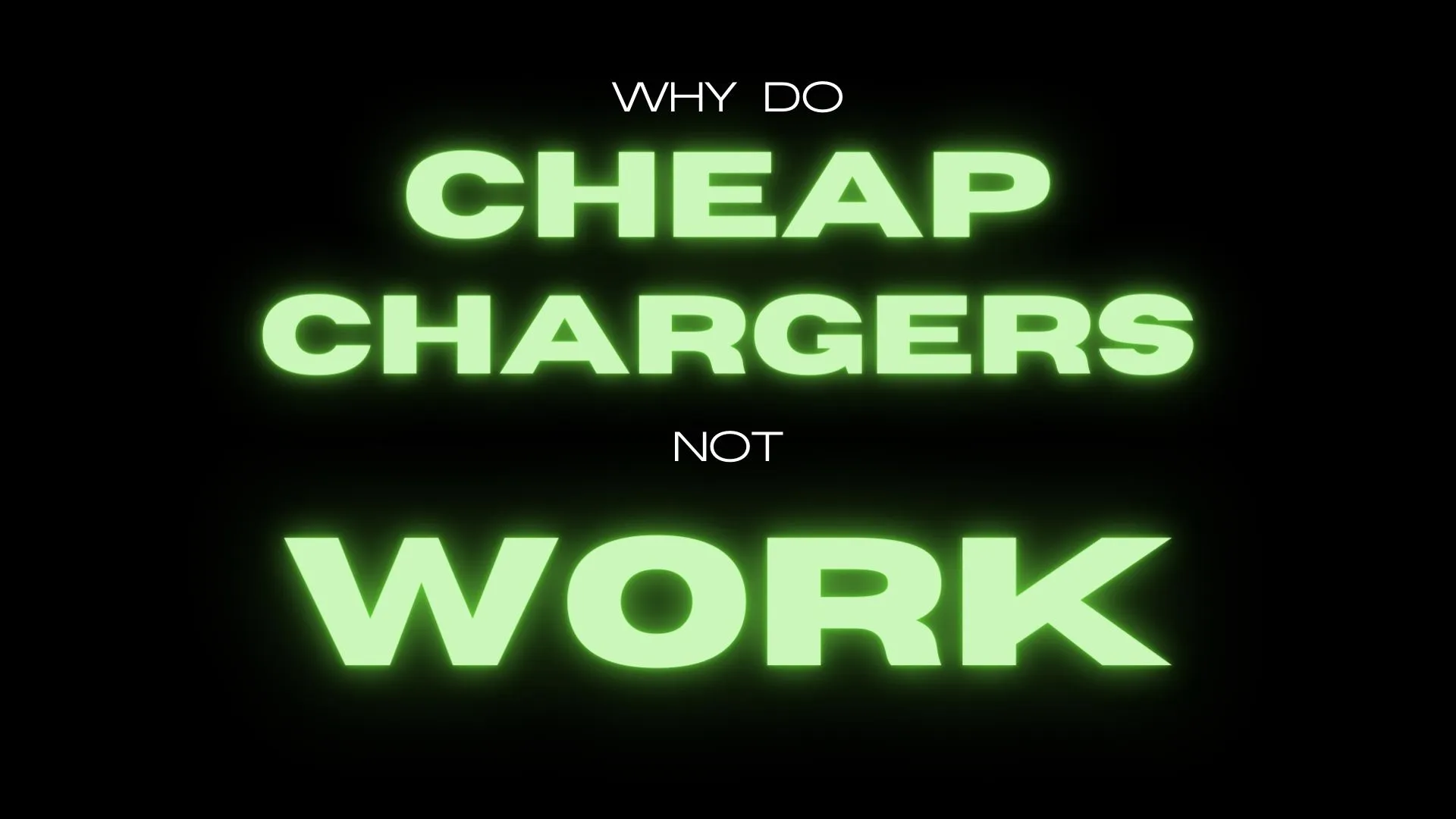Don’t let a cheap charger ruin your day – find out why they don’t work and what you can do about it. Read it now: Why Do Cheap Chargers Not Work
If you’re like me, you’re often tempted by the low price tag of a cheap charger. But the consequences of using a low-quality charger can be disastrous. And I’m not only talking apocalyptic levels of bad. Using a faulty charger can be as dangerous as trying to milk a cow with a fork.
In this post, I will look at why cheap chargers fail and which factors make them inefficient.
One reason why cheap chargers can be a risky gamble is their lack of quality control. Many use subpar components, which can cause voltage fluctuations or short circuits.
I once had a cheap charger that overheated and damaged my battery. It rendered the device unusable. This not only cost me more in the long run, but it also posed a massive fire risk.
As well as the risks of using cheapo chargers, they also tend to stop working. This is usually due to poor assembly or faulty wiring.
Table of Contents
So Why Do Cheap Chargers Not Work
Here are a couple of main reasons for the issues faced by cheap chargers:
| Cause | Problem | Solution | Consequence |
|---|---|---|---|
| Poor quality components, lack of safety features | Overheating | Use a high-quality charger with safety features | Fire, explosion, damage to device |
| Inadequate power output, poor design | Slow charging | Choose a charger with sufficient power output and a reputable brand | Inconvenience, reduced battery life |
| Poor quality components, lack of regulation | Inconsistent charging | Use a charger with proper voltage regulation and a reputable brand | Unreliable performance, damage to device |
| Poor design, lack of information | Compatibility issues | Choose a charger that is compatible with your device and has clear specifications | Inability to charge certain devices, damage to device |
| Poor quality components, inadequate design | Short lifespan | Invest in a high-quality charger with a reputable brand and proper design | Inconvenience, need for frequent replacement |
Quality and Performance Issues
The main problem with budget chargers is that they often use poor-quality components and lack proper safety features. This in turn leads to inconsistent power output. This inconsistent output can then cause your phone’s battery to overheat.
There are three main causes of this inconsistent output.
- Firstly, cheap chargers often have bad capacitors, which can cause the power to go up and down.
- Secondly, the transformers in cheap chargers are not well made. So they don’t work as well and can cause the power to be unstable.
- And last, cheap chargers may not use the correct means to regulate the power. So they can give too much or too little power to your device.
Another factor to consider is the quality of the charging cable itself. A damaged cable with exposed or broken wires is sub-optimal. It can cause charging failures or potential safety hazards. According to MakeUseOf, cuts and bends are two common causes of cable damage.
But why are substandard parts used?

Manufacturers of cheap chargers often cut corners to cut production costs. An easy way to do this is by using low-quality components or skipping important safety features. Some cheap chargers lack filters and voltage protection. This can cause damage to a device’s PMIC (Power Management Integrated Circuit). In this case, it would stop the device from charging altogether.
Another area where manufacturers look to cut costs is in the workforce. In some cases, manufacturers employ unskilled workers or even underpay their skilled laborers. This affects the quality of work and leads to a less-than-ideal product. Using underpaid labor forces to assemble the chargers can result in errors and inconsistencies. But the need to continue to produce cheap chargers means a reluctance to invest in automation.
Potential Hazards of Cheap Chargers
Let’s talk about the potential hazards of cheap chargers.
Damage to Devices
While it might feel good to save a few bucks on a charger, it can actually harm your device. A cheap charger can lead to damage or malfunction in phones, tablets, and other devices.
This can include battery damage. In extreme cases, the battery may even explode. And with phones costing as much as 2000 bucks these days, is it worth the risk to save five bucks on an unbranded charger?
Electrical Safety Risks
When it comes to electrical safety, going cheap can be a big mistake. A cheap charger may cause burns or fires, as well as electrical shock or electrocution.
For example, a study found that 99% of counterfeit Apple chargers fail basic safety checks. This is enough to think twice about using a cheap charger. It can put our loved ones at risk.
Here’s a quick look at some of the difficulties with cheap chargers and cables:
The Importance of Certification
In this section, I’ll discuss industry standards and how to recognize certified chargers. These certifications mean that your safety is best protected.
Industry Standards
The industry has worked hard to create standards for chargers. These standards make sure the chargers are safe and effective. Companies like UL Solutions test and certify battery chargers to ensure their quality. When a charger meets these standards, it gets a stamp of approval.
If a charger doesn’t meet these standards, it can cause problems. For example, cheap iPhone chargers have led to accidents and injuries.
Recognizing Certified Chargers
Look for specific markings or logos on the charger. For instance, USB-IF certification shows that a USB charger has undergone rigorous testing. Keep in mind that this certification only covers the chargers, not the cables.
When it comes to Apple devices, choose MFi-certified chargers. This certification means the charger meets Apple’s strict guidelines for performance and safety. It’s a clear sign of a high-quality, safe charger.
The Benefits of Investing in Quality Chargers
Here are some of the benefits of going expensive.
A quick Charge.
It is undeniable that using the manufacturer’s charger is super quick. And we can see when we plug in our device the estimated time to full charge. I have never seen a budget charger that is quicker than the correct charger.
Protection for Your Device
Using a high-quality charger protects my devices from potential damage. Cheap chargers often lack essential safety features, like voltage regulation and filtering. Harmful electrical surges may hit my device.
Longevity and Reliability
Purchasing a quality charger means I can rely on it to work for an extended period. High-quality chargers are made with good materials that undergo rigorous testing. As a result, investing in a quality charger means I spend less replacing faulty chargers.
Compatibility
Quality chargers are often designed to be compatible with a range of devices. This means that even if I upgrade my device, I can still use the same charger. Cheap chargers may not work well with different devices. In extremis, they cause damage due to poorly designed connectors or compatibility issues.
Cheap chargers fail due to low-quality components and a lack of voltage regulation. These issues can lead to an inconsistent power supply. This causes them to damage the devices they’re meant to charge. Moreover, prioritizing safety is crucial. Cheap chargers pose risks that you should not overlook.
These days, I choose chargers that meet regulatory standards from reputable manufacturers. In the long run, this decision not only protects my devices but also ensures my well-being.
Before You Go
Congratulations, you’ve made it to the end of this article!
But before you go, I want to share something important with you. Using a cheap charger may seem like a harmless way to save money, but it can have serious consequences.
Not only can it damage your devices, but it can also pose a risk of fire or explosion. That’s why I urge you to read our next post, “Why do Battery Chargers Explode“.
It will reveal the shocking reality of this problem and help you understand why it’s so important to use a high-quality charger. Don’t let a cheap charger put you in harm’s way – read this post and stay safe.
FAQ
Here’s the FAQs
Why do cheap chargers have inconsistent charging performance?
Inconsistent charging can be caused by poor quality components or lack of voltage regulation, which can lead to unreliable performance and damage to your device.
Why do cheap chargers charge slowly?
Cheap chargers may have inadequate power output or poor design, which can result in slower charging times and reduced battery life.
Why do cheap chargers overheat?
Cheap chargers often use poor quality components and lack safety features like overcurrent protection, which can cause them to overheat and potentially catch fire or explode.
Why do cheap chargers have compatibility issues?
Cheap chargers may have poor design or lack of information about their specifications, which can result in incompatibility with certain devices and potential damage to your device.
Why do cheap chargers have a short lifespan
Cheap chargers may have poor quality components or inadequate design, which can lead to a shorter lifespan and the need for frequent replacement.
How can I avoid the risks of using a cheap charger?
To avoid the risks of using a cheap charger, it’s important to invest in a high-quality charger from a reputable brand that has proper safety features, adequate power output, and clear specifications.
Why do cheap chargers charge slowly?
Cheap chargers may have inadequate power output or poor design, which can result in slower charging times and reduced battery life.
Why do cheap chargers overheat
Cheap chargers often use poor-quality components and lack safety features like overcurrent protection, which can cause them to overheat and potentially catch fire or explode.
Related Articles
- How to Charge Your Phone Battery – We Explain All in our Helpful Ultimate Guide
- What’s the difference between a discount store battery charger and an industrially rated unit? Find out 6 BIG differences here.
- What Causes a Battery Charger to Explode: The Shocking Reality you NEED to know
- Is It Bad to Use Your Phone While Charging? How to use your device explained


